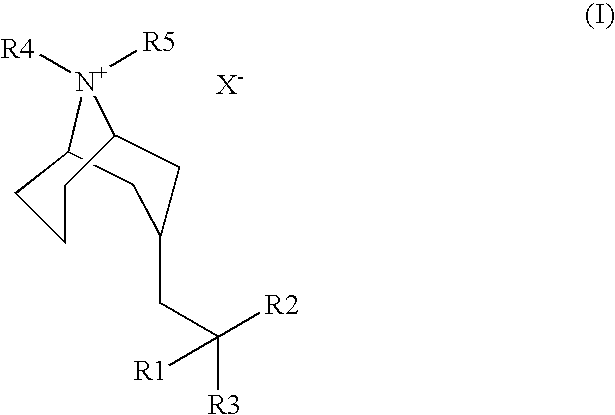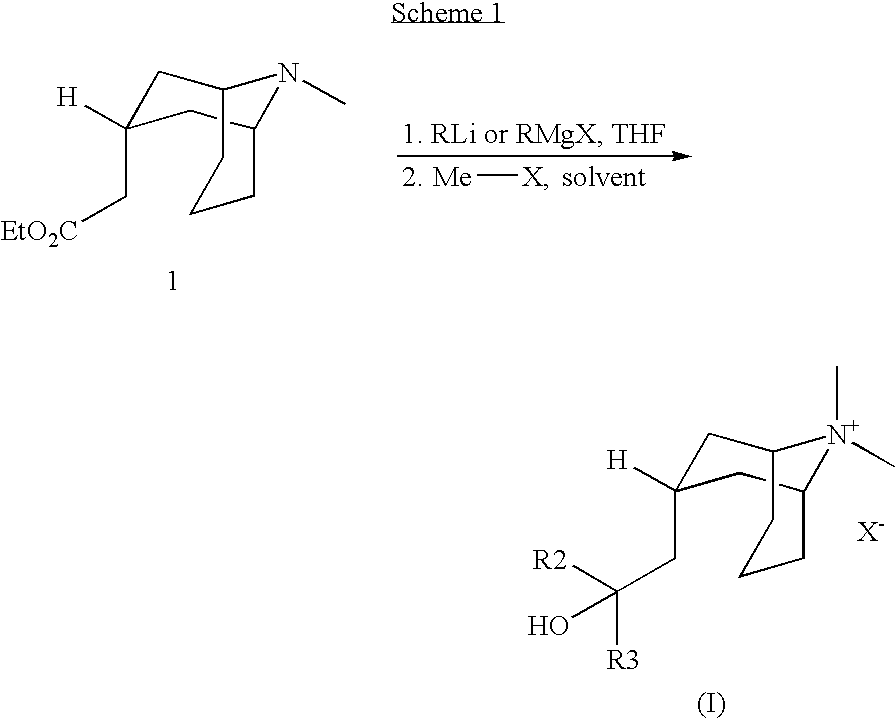Muscarinic Acetycholine Receptor Antagonists
a technology of acetycholine receptor and muscarinic acid, which is applied in the field of 9azabicyclo3 . 3 . 1nonane derivatives, can solve the problems of airway hyperreactivity and hyperresponsiveness, relatively few anti-cholinergic compounds are available for use in the clinic, and the product is currently not available in the united states
- Summary
- Abstract
- Description
- Claims
- Application Information
AI Technical Summary
Benefits of technology
Problems solved by technology
Method used
Image
Examples
example 1
2-[(3-Endo)-9-methyl-9-azabicyclo[3.3.1]non-3-yl]-1,1-di-2-thienylethanol
[0060] A solution of 1 (273 mg, 1.21 mmol) in THF (3 mL) was added dropwise with stirring to a 1 M solution of 2-thienyllithium in THF (4.8 mL, 4.8 mmol) at −30° C. (bath temp) under argon. The ice bath was removed and stirring was continued for 5 h, whereupon H2O (3 mL) was added. The layers were separated, and the aqueous layer was extracted with EtOAc (3×2 mL). The combined organic layers were washed with saturated NaCl (1×1 mL), dried (Na2SO4), and concentrated under reduced pressure. The crude product was purified by flash chromatography on silica gel (20 g) eluting with 5% MeOH / CH2Cl2 (600 mL), followed by 10% MeOH / CH2Cl2 (300 mL) to give 145 mg (48%) of Example 1.
[0061] LC / MS ESI RT 1.17 min MH+ 226.2
example 2
3-[(3-Endo)-9-methyl-9-azabicyclo[3.3.1]non-3-yl]-2,2-di-2-thienylpropanenitrile
[0062] AlCl3 (176 mg, 1.33 mmol) was added to a slurry of Example 1 (95 mg, 0.27 mmol) in dichloroethane (5.3 mL) in a 2 dram vial. The vial was sealed with a Teflon-lined screwcap and the reaction was stirred at room temperature for 10 min. Trimethylsilyl cyanide (TMSCN, 0.18 mL, 1.33 mmol) was then added, the vial was resealed, and the reaction was stirred at 85° C. (bath temp) for 20 h. The reaction was stirred at room temperature for 10 min, and a further portion of AlCl3 (176 mg, 1.33 mmol) was added. Stirring continued for 10 min, whereupon another portion of TMSCN (0.18 mL, 1.33 mmol) was added. The reaction was stirred at 85° C. for 40 h, and the reaction was poured into a 2:1 mixture of saturated K2CO3 / EtOAc (30 mL) with stirring. The black precipitate was filtered off, and the filter cake was rinsed with EtOAc (3×5 mL). The layers of the filtrate were separated, and the aqueous layer was extra...
example 3
2-[(3-Endo)-9-methyl-9-azabicyclo[3.3.1]non-3-yl]-1,1-diphenylethanol
[0066] A solution of 1 (315 mg, 1.40 mmol) in THF (7 mL) was added to a 1.5 M solution of PhLi in 70:30 cyclohexane / Et2O (3.73 mL, 5.6 mmol) at −30° C. (bath temp) under argon. The ice bath was removed, and the reaction was stirred for 3 h, whereupon H2O (5 mL) was added, followed by EtOAc (5 mL). The layers were separated, and the aqueous layer was extracted with EtOAc (4×2 mL). The combined organic layers were washed with saturated NaCl (1×5 mL), dried (Na2SO4), and concentrated under reduced pressure. The crude product was purified on a Biotage 25+S cartridge (20 g silica gel) at 5 psi eluting with 0.5% aqu NH4OH / 10% MeOH / CH2Cl2 (2 L) to give 295 mg (63%) of Example 3.
[0067] LC / MS ESI RT 1.66 min MH+ 336.2
PUM
| Property | Measurement | Unit |
|---|---|---|
| Time | aaaaa | aaaaa |
| Time | aaaaa | aaaaa |
| Time | aaaaa | aaaaa |
Abstract
Description
Claims
Application Information
 Login to View More
Login to View More - R&D
- Intellectual Property
- Life Sciences
- Materials
- Tech Scout
- Unparalleled Data Quality
- Higher Quality Content
- 60% Fewer Hallucinations
Browse by: Latest US Patents, China's latest patents, Technical Efficacy Thesaurus, Application Domain, Technology Topic, Popular Technical Reports.
© 2025 PatSnap. All rights reserved.Legal|Privacy policy|Modern Slavery Act Transparency Statement|Sitemap|About US| Contact US: help@patsnap.com



